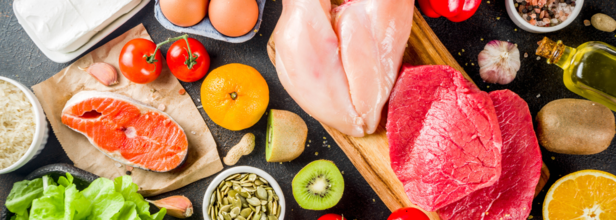- Health Conditions A-Z
- Health & Wellness
- Nutrition
- Fitness
- Health News
- Ayurveda
- Videos
- Medicine A-Z
- Parenting
What Is The Whole30 Diet?

Credits: Canva
So far, we have covered many different kinds of diets, including the Harvard Diet, the Paleo Diet, the Vestibular Migraine Diet, the Portfolio Diet and the F-Factor Diet. Another one that is on the list and something that people turn to for weight loss or help with digestive concerns is the Whole30 diet.
It is a strict 30-day elimination diet that cuts out alcohol, sugar, grains, legumes, dairy, and additives from your diet, straight for 30 days. It is advertised as a total lifestyle change, rather than a simple diet.
What is a Whole30 diet?
As the name suggests, it also focuses on a 30-day-long diet that promises a variety of health and emotional benefits. It was first developed in 2009 by two certified sports nutritionists who promoted it as a way to reset your metabolism and reshape your relationship with foods.
The Whole30 program is built on the idea that certain foods—like sugar, grains, legumes, alcohol, and dairy—may negatively affect your health and overall fitness. By removing these items from your diet, the program aims to help your body recover, reset, and achieve long-term health. Many people adopt this plan to lose weight, identify food intolerances, or improve their relationship with food.
What Is the Whole30 Diet?
The Whole30 diet is a strict, month-long elimination program that encourages eating minimally processed, whole foods while avoiding specific items believed to cause inflammation or disrupt hormones. This approach emphasizes a reset period where no deviations from the rules are allowed. The program claims to improve physical and emotional well-being by changing how you view food.
Unlike other diets, the Whole30 does not require calorie counting, portion control, or daily weigh-ins. Instead, weight tracking is only allowed on days 1 and 30 to keep the focus on overall health rather than just the scale.
How to Follow the Whole30 Diet?
For 30 days, participants completely avoid certain foods and focus on approved options. After this elimination phase, foods are gradually reintroduced to assess how they impact the body. This reintroduction phase helps identify triggers for bloating, skin issues, or other negative symptoms.
Adherence is key; any slip-ups mean starting the program over. The Whole30 encourages mindful eating and aims to reshape unhealthy food habits.
What are the benefits of this 30-day long elimination?
- Weight Loss: Though not the primary focus, many people report fat loss.
- Higher Energy Levels: Improved food choices may combat fatigue.
- Better Sleep: Whole foods can contribute to restful sleep.
- Reduced Cravings: Eliminating sugar and processed foods may lower cravings.
- Improved Athletic Performance: A focus on nutrient-dense foods supports active lifestyles.
Despite these claims, there is no scientific evidence directly supporting the benefits of the Whole30 diet.
What is allowed?
- Proteins: Chicken, turkey, fish, and eggs.
- Fruits and Vegetables: Fresh, dried fruits, and all vegetables.
- Nuts and Seeds: Except peanuts (considered legumes).
- Fats: Olive oil, ghee, avocado oil, and animal fats.
What is not allowed?
- Sugar and Sweeteners: Including honey and artificial sweeteners.
- Alcohol: All types of beer, wine, and spirits.
- Grains and Legumes: Wheat, rice, lentils, and soy products.
- Dairy: Milk, yogurt, cheese, and other dairy products.
- Processed Additives: MSG, carrageenan, and sulfites.
Even creating “healthy” versions of indulgent foods like paleo pancakes or cauliflower pizza is discouraged.
What happens after you have completed your 30-day routine?
After completing the 30-day elimination period, the reintroduction phase begins. Foods are added back one group at a time, allowing participants to observe how their body reacts. For example, dairy might be reintroduced on day 1, followed by three days of Whole30 eating. This process helps pinpoint food sensitivities and identify which items to avoid in the future.
Christmas Delights Mince Pies Urgently Recalled In UK, Know Why

Credits: Canva
Mince pies, a Christmas delight, has been recalled just a few hours before Christmas in UK, over dangerous 'health risks'. The Food Standards Agency (FSA) warned consumers that there could be certain allergies and intolerances that could occur.
Why Are Mince Pies Recalled?
Shallow Brandy Mince Pies by the Bakewell baker have been recalled because it contains milk, "which is not mentioned on the label", noted the FSA notice, issued on December 23.
"The product is a health risk for anyone with an allergy or intolerance to milk or milk constituents," read the FSA notice.
The affected batch include six packs with the following best before dates: 2 February 2026, 3 February 2026, 4 February 2026, and 5 February 2026.
What Does The FSA Notice Say?
Why is the product being recalled?
We have identified that it has been labels incorrectly. Allergen missing. Product contains
milk not declared labels an ingredient has. This may pose a risk to customers.
What should customers do?
Please call the office.
• If you have purchased this product, please do not consume it.
• Return it to the store where it was bought for a full refund. No receipt is required.
FSA issued a "do not consume" notice to warn customer who could be affected.
What Happens When Lactose Intolerant People Consume Milk Or Milk Based Products?
When lactose intolerant people consume milk or milk-based products their bodies cannot properly digest the lactose sugar, leading to uncomfortable digestive symptoms like gas, bloating, cramps, abdominal pain, rumbling sounds, nausea, and diarrhea, usually within 30 minutes to 2 hours, because the undigested lactose ferments in the gut. Severity varies by individual, but it's generally a harmless condition, manageable by limiting dairy or using lactase supplements, and is different from a milk allergy.
Common Symptoms
- Gas & Bloating: Bacteria in the large intestine ferment the lactose, producing gas and causing the gut to stretch.
- Cramps & Pain: Fermentation creates acids and gases, leading to pain around the navel and lower abdomen.
- Diarrhea: Excess water and gas in the colon can result in loose stools.
- Nausea & Vomiting: Some people experience nausea or may even vomit.
- Stomach Noises: You might hear rumbling or "growling" sounds
However, not everyone is lactose intolerant, some may have an allergy from milk, which could lead to different allergy symptoms, which include:
- Hives
- Skin rash
- Stomach upset
- Runny Nose
In fact, severe symptoms could also lead to wheezing, throat swelling, difficulty breathing, vomiting, anaphylaxis.
Are There Any Alternatives To Mince Pies?
There are mince pies available without milk or using any dairy. These dairy-free pastry, which are often made with vegetable oils or vegan butter substitute plant-based milk for brushing, or skipping the milk wash entirely. Traditional pie crusts use ice water as the liquid, so replacing milk is easier.
Always pay attention to be label to know if it contains any ingredient you may be allergic to.
Why is Butyrate Called Gut Petrol, Are You Low On It? Here's How Changing Your Diet Can Help

Credits: iStock
Your gut's petrol maybe running low and it is causing you all sorts of gut issues. But, what does it really mean?
Bloating that doesn’t settle, gas that feels unpredictable, sluggish digestion, and a constant sense that your gut just isn’t cooperating anymore. All of these complaints are becoming increasingly common, especially in urban India. While many people blame stress or food intolerances, experts say the issue may lie deeper, at the level of the gut microbiome. One key reason: falling levels of butyrate, a small but powerful compound essential for gut health.
Often described as the gut’s “petrol,” butyrate plays a critical role in keeping the digestive system resilient and balanced.
What Is Butyrate and Why Does It Matter?
Butyrate is a short-chain fatty acid (SCFA) produced when beneficial gut bacteria ferment dietary fiber. Think of it as the primary fuel source for the cells lining the colon. When enough butyrate is present, the gut lining stays strong, inflammation remains under control, and digestion functions smoothly.
When levels drop, the gut barrier weakens. This can lead to inflammation, slower digestion, immune imbalance, and even disruptions in metabolism and mood. In simple terms, low butyrate means the gut struggles to repair and protect itself.
A Silent Deficiency on the Rise
Recent gut microbiome analyses suggest that butyrate levels are declining sharply, particularly among adults living in metro cities. The drop isn’t limited to older age groups, even people in their 20s and 30s are showing early signs of imbalance.
While other SCFAs like propionate and acetate may remain relatively stable, butyrate appears to be the first to fall. This imbalance is increasingly being linked to rising cases of irritable bowel symptoms, unexplained digestive discomfort, and metabolic issues, even when routine tests appear normal.
What Low Butyrate Says About Your Gut
Low butyrate usually signals one of two problems, or both. Either the butyrate-producing bacteria are disappearing, or the diet lacks the fibers those bacteria depend on. Many people believe they eat “healthy,” yet still miss out on fiber diversity.
Without adequate fuel, beneficial bacteria struggle to survive. As a result, the gut ecosystem shifts, leading to symptoms such as bloating, cramps, urgency, alternating constipation and loose stools, fatigue, brain fog, and sugar cravings. These issues often go undetected because structural tests show no obvious damage.
How Modern Diets Are Fueling the Problem
Traditional Indian diets once provided a wide range of fibers through millets, dals, vegetables, fermented foods, and seasonal produce. Over time, these have been replaced by ultra-processed foods that are low in fiber and high in sugar and refined carbohydrates.
Add irregular meal timings, chronic stress, poor sleep, frequent antibiotic or painkiller use, and environmental pollution, and the gut microbiome takes a hit. The bacteria that produce butyrate simply fade away, much like shutting down a factory that no longer receives raw materials.
Rebuilding Butyrate Naturally
Restoring butyrate isn’t about quick fixes. Supplements may provide temporary relief, but they don’t rebuild the ecosystem. The foundation is dietary diversity.
Foods that help feed butyrate-producing bacteria include millets, legumes, whole grains, fruits, vegetables, seeds, and resistant starches. Everyday foods such as bananas, onions, garlic, oats, and cooked-and-cooled rice act as natural prebiotics. Fermented foods like curd and buttermilk also support microbial balance.
With consistent changes, the gut can slowly restart its butyrate production, though meaningful recovery may take several months.
Why Fiber Awareness Matters More Than Ever
Low butyrate isn’t just a digestive issue. It reflects how modern lifestyles are reshaping gut health at a population level. Improving fiber diversity could strengthen immunity, metabolism, and long-term health more effectively than treating symptoms later.
In many ways, restoring butyrate means returning to simpler, whole-food eating habits — and giving the gut the fuel it was designed to run on.
This Popular Christmas Food Could Raise Your Risk of Cancer And Heart Attack

Credits: Canva
Millions of people are stocking up on food for Christmas, planning the main meal and everything that comes with the festive stretch. What many do not realise is that there is a proven link between cancer and one much-loved item that often sits on the Christmas Day plate.
While sugar is often blamed for causing cancer, that belief is not supported by evidence. In fact, only two foods have a confirmed, direct link to cancer: alcohol and processed meat. And popular pigs in blankets clearly fall into the processed meat category.
Popular Christmas Food Could Raise Your Risk of Cancer And Heart Attack
To be clear, no one is saying that eating pigs in blankets on Christmas Day will give you cancer, just as no one suggests that a single glass of wine or sherry will lead to a diagnosis. That said, recent scientific evidence shows there is no truly safe level of alcohol consumption. In a recent report, Vivek Murthy, former surgeon general of the US Public Health Service, warned that alcohol use has been directly linked to at least seven different types of cancer, and that even light or moderate drinking can raise a person’s cancer risk.
As per Mirror, both processed meat and alcohol are classified as Group 1 carcinogens by the World Health Organisation, which means there is clear evidence they can cause cancer in humans. According to the WHO, “There is convincing evidence that the agent causes cancer.” Tobacco smoking and asbestos are also listed as Group 1 carcinogens, although the organisation clarifies that this does not mean alcohol and processed meat are as dangerous as smoking or asbestos.
Cancer Research UK also states clearly, “We know for certain that processed meat causes cancer. We are as confident about this link as we are about other established causes of cancer, such as tobacco and alcohol.”
What Is Processed Meat?
The World Health Organisation defines processed meat as “meat that has been transformed through salting, curing, fermentation, smoking, or other processes to enhance flavour or improve preservation.” Sausages and bacon are commonly cited examples by both the WHO and Cancer Research UK.Cancer Research UK explains that processed meats contain chemicals that are either added during processing or formed during cooking. These include nitrates and nitrites, which help keep processed meat fresh for longer. The organisation notes, “When we consume them, nitrates and nitrites can turn into N-nitroso chemicals (NOCs), which can damage the cells lining the bowel. This damage can increase the risk of bowel cancer.”
Why Does Alcohol Cause Cancer?
Alcohol increases cancer risk through biological processes that occur as it is broken down in the body. This means that any alcoholic drink, regardless of how expensive, high-quality, or mild it may seem, carries a cancer risk. There is no safe threshold for drinking alcohol. The WHO says cancer risk “rises significantly the more alcohol is consumed,” but also points out that “the latest available data show that around half of all alcohol-related cancers are caused by ‘light’ and ‘moderate’ drinking,” defined as less than 1.5 litres of wine, less than 3.5 litres of beer, or under 450 millilitres of spirits per week.
Processed Meat And Heart Disease
In 2021, researchers at Oxford University reported that the “largest review of all large-scale studies to date shows red and processed meat increase the risk of heart disease.”
Worldwide, coronary heart disease causes nearly nine million deaths each year, making it the leading cause of death globally. Scientists from the University of Oxford’s Nuffield Department of Population Health said their analysis “showed that each additional 50g per day of processed meat, such as bacon, ham, or sausages, was linked to an 18% higher risk of coronary heart disease.”
© 2024 Bennett, Coleman & Company Limited

